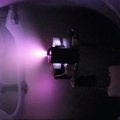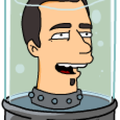 However, for plasma thruster testing, 10^-5 is more than fine, and where I start operating at. technically, 10^-4 is the bare recommended rule of thumb min for plasma thrusters, but you want at least a decade overhead in your pumping requirements
However, for plasma thruster testing, 10^-5 is more than fine, and where I start operating at. technically, 10^-4 is the bare recommended rule of thumb min for plasma thrusters, but you want at least a decade overhead in your pumping requirements
 If you can do local pickup, sometimes entire SEMs that include vacuum chamber, pumps, and controllers is cheaper than buying them seperately
If you can do local pickup, sometimes entire SEMs that include vacuum chamber, pumps, and controllers is cheaper than buying them seperately
 Actually, my vacuum system is very simple compared to a lot of other enthusiasts out there
Actually, my vacuum system is very simple compared to a lot of other enthusiasts out there
![]() I assumed the vac test videos I saw were at a facility designed for that kind of thing. Very cool. Is your background specifically in astro thrusters?
I assumed the vac test videos I saw were at a facility designed for that kind of thing. Very cool. Is your background specifically in astro thrusters?
 i just joined, sorry if this was covered, i heard for some very high vacuum stuff, you bake the chamber to remove gases that 'stick' to the sides iirc, do you do anything like that?
i just joined, sorry if this was covered, i heard for some very high vacuum stuff, you bake the chamber to remove gases that 'stick' to the sides iirc, do you do anything like that?
 SEMs are great, however not really ideal for a thruster chamber. You could get a simple one much cheaper. Mine is based off of only 2 6" conflat tees. It shows that you can do this testing with an incredibly small system, as opposed to the often massive chambers you seen that you can walk into that most places have
SEMs are great, however not really ideal for a thruster chamber. You could get a simple one much cheaper. Mine is based off of only 2 6" conflat tees. It shows that you can do this testing with an incredibly small system, as opposed to the often massive chambers you seen that you can walk into that most places have
 @Bob nope, no formal background in any thruster stuff. However, I have come to study and specialize in areas such as plasma, pulsed power, high voltage, particle beams, and high vacuum on my own, which all comes together for this stuff
@Bob nope, no formal background in any thruster stuff. However, I have come to study and specialize in areas such as plasma, pulsed power, high voltage, particle beams, and high vacuum on my own, which all comes together for this stuff
 @anfractuosity actually, i don't need to bake for my system. Pumping speed is so high for the small chamber, and I don't need to reach UHV that it's not really necessary. Only really need to bake if trying to break past the 10^-7 and higher range
@anfractuosity actually, i don't need to bake for my system. Pumping speed is so high for the small chamber, and I don't need to reach UHV that it's not really necessary. Only really need to bake if trying to break past the 10^-7 and higher range
![]() Encouraging stuff. I'm working my way towards an astronautical engineering path, kind of picking your experience for tips to get my feet wet before I reach that part of my education :)
Encouraging stuff. I'm working my way towards an astronautical engineering path, kind of picking your experience for tips to get my feet wet before I reach that part of my education :)
 aha, gotcha, thanks!
aha, gotcha, thanks!
 But yes, baking is used to desorb the gasses, and is definitely needed for most UHV applications
But yes, baking is used to desorb the gasses, and is definitely needed for most UHV applications
 Are vacuum chambers needed to test the thrusters? Because once you have launched the satellite into space there won't be any need of vacuum chambers.
Are vacuum chambers needed to test the thrusters? Because once you have launched the satellite into space there won't be any need of vacuum chambers.
 @yashelite Yes, vacuum is needed for ground testing. You need to be able to generate high vacuum at the ground level. Once in space, it is already in vacuum. These thrusters just won't work at atmosphere
@yashelite Yes, vacuum is needed for ground testing. You need to be able to generate high vacuum at the ground level. Once in space, it is already in vacuum. These thrusters just won't work at atmosphere
 Actually, I precheck the PPTs in atmosphere by firing the igniter and listening for the spark "click" sound. Since it is not in vacuum, the main bank can't fire. It allows me to check HV and ignition circuitry, then I test ignition at high vacuum after everything is verified
Actually, I precheck the PPTs in atmosphere by firing the igniter and listening for the spark "click" sound. Since it is not in vacuum, the main bank can't fire. It allows me to check HV and ignition circuitry, then I test ignition at high vacuum after everything is verified
 for ILIS though everything must be tested at high vacuum.
for ILIS though everything must be tested at high vacuum.
 Spark plug thrusters and EMC. How to be able to have circuitry next to it?
Spark plug thrusters and EMC. How to be able to have circuitry next to it?
 hi and thanks for the chat with us.
hi and thanks for the chat with us.
how about power during the orbit cubesat mission. how much power does the system need and is it more like charging it for a long time and then bursting it out in a short period of thrust?
 @Jonny Wester well, that can be a challenge. The PPT at least can crash the arduino which poses some testing issues for sure. For onboard testing, that is one thing that will be checked with qualifications with the GENESIS mission, to see if it interferes with the computer and if shielding is required. Usually for PPTs, some form of EMF shielding is needed
@Jonny Wester well, that can be a challenge. The PPT at least can crash the arduino which poses some testing issues for sure. For onboard testing, that is one thing that will be checked with qualifications with the GENESIS mission, to see if it interferes with the computer and if shielding is required. Usually for PPTs, some form of EMF shielding is needed
 @Applied Ion Systems I am checking on the current status of nuclear propulsion. I have been tracking develoments for nearly 50 years. Your immediate reaction reflects the poor state of developments and poor options currently available. I know of some alternatives but they are not cost effective for anything less that a few hundred kilowatts. And they are not radioactive but use inner bond energies that are intermediate between the 0-10 eV per bond of chemicals and the roughly 2 MeV per bond of "nuclear". I call these "intermediate" or "atomic" energy reactions. They range from 10 eV per bond up to 2 MeV per bond. They will not work in plasma, but only very very precise atomic beams. There are many electron reactions that are good candidates for intermediate storage. Several of the aneutronic fusion reactions are members of this much larger class of intermediate energy reactions. They are actually fairly easy to model since they use classical quantum mechanics and electrodynamics. And the reactions are essentially independent events.
@Applied Ion Systems I am checking on the current status of nuclear propulsion. I have been tracking develoments for nearly 50 years. Your immediate reaction reflects the poor state of developments and poor options currently available. I know of some alternatives but they are not cost effective for anything less that a few hundred kilowatts. And they are not radioactive but use inner bond energies that are intermediate between the 0-10 eV per bond of chemicals and the roughly 2 MeV per bond of "nuclear". I call these "intermediate" or "atomic" energy reactions. They range from 10 eV per bond up to 2 MeV per bond. They will not work in plasma, but only very very precise atomic beams. There are many electron reactions that are good candidates for intermediate storage. Several of the aneutronic fusion reactions are members of this much larger class of intermediate energy reactions. They are actually fairly easy to model since they use classical quantum mechanics and electrodynamics. And the reactions are essentially independent events.
 @hornig that is the big question. Ultimate performance capabilities of EP is first and foremost limited by onboard power. For a 1P PQ, I have maybe a few hundred mW to play with. While the PPT I designed for them will fire, it just cannot provide useful thrust at that power input - the scaling for this tech doesn't work out. Switching to ILIS, at the 1.5W power level, it can provide significant thrust, enough for station keeping and orbital manuevers. this would be suited for a well equipped 2P or 3P PQ, and getting into the small Cubesat range easily
@hornig that is the big question. Ultimate performance capabilities of EP is first and foremost limited by onboard power. For a 1P PQ, I have maybe a few hundred mW to play with. While the PPT I designed for them will fire, it just cannot provide useful thrust at that power input - the scaling for this tech doesn't work out. Switching to ILIS, at the 1.5W power level, it can provide significant thrust, enough for station keeping and orbital manuevers. this would be suited for a well equipped 2P or 3P PQ, and getting into the small Cubesat range easily
 We have trouble with controlling an anchor system, so I can imagine. And a plain Arduino! Amazing...tin foil will not be enough. Opto isolation and really thought out shielding would be needed.
We have trouble with controlling an anchor system, so I can imagine. And a plain Arduino! Amazing...tin foil will not be enough. Opto isolation and really thought out shielding would be needed.
 We're an hour into the chat now, so we have to let Michael get back to work if he needs to. Everyone is welcome to stay on the chat is they have time, of course. I want to thank Michael for tolerating several reschedulings to finally be with us today. I really enjoyed this chat, learned a lot. Thanks Michael!
We're an hour into the chat now, so we have to let Michael get back to work if he needs to. Everyone is welcome to stay on the chat is they have time, of course. I want to thank Michael for tolerating several reschedulings to finally be with us today. I really enjoyed this chat, learned a lot. Thanks Michael!
 Or soft sparking...!
Or soft sparking...!
![]() Thanks for being here, Michael. Fascinating project and results -- good luck in the future!
Thanks for being here, Michael. Fascinating project and results -- good luck in the future!
 And next week we'll be switching gears entirely for the last Hack Chat of 2019. We'll have Shahriar from The Signal Path on to talk about the weird world of microwave electronics:
And next week we'll be switching gears entirely for the last Hack Chat of 2019. We'll have Shahriar from The Signal Path on to talk about the weird world of microwave electronics:

https://hackaday.io/event/167683-weird-world-of-microwaves-hack-chat
Weird World of Microwaves Hack Chat
Shahriar Shahramian joins us for the Hack Chat on Wednesday, December 18, 2019 at noon PST. Time zones got you down? Here's a handy time converter! Shahriar is no stranger to this land. He's been studying millimeter-wave systems for decades, and his day job is researching millimeter-wave ASICs for Nokia Bell Labs in New Jersey.
 @Dan Maloney thanks for the awesome opportunity to chat! I am actually free for a while to continue if anyone would like to chat more
@Dan Maloney thanks for the awesome opportunity to chat! I am actually free for a while to continue if anyone would like to chat more
 You bet. I'll wait a while to pull the transcript then, so we capture all the details. Thanks!
You bet. I'll wait a while to pull the transcript then, so we capture all the details. Thanks!
 I can't see the electronics work nearby the thousands of amps being switched next to it. We have a problem already at 100A....
I can't see the electronics work nearby the thousands of amps being switched next to it. We have a problem already at 100A....
 Thanks for that, a glimpse into the world of a true pioneer. :-D
Thanks for that, a glimpse into the world of a true pioneer. :-D
![]() Thanks for everything, It was great listening in
Thanks for everything, It was great listening in
 @Applied Ion Systems no worries :). it is all about the strategie of how you do your demonstration run. I do space for a living and having a small well defined test is always another step into the right direction. even if you are charging the PQ batteries for some orbits and the use this for your tests, it will be usefull to know if you can get your system running and get you a higher TRL (tech readiness level). I would like to se you moving the pq into another orbit over a long time. (I do sat tracking) :)
@Applied Ion Systems no worries :). it is all about the strategie of how you do your demonstration run. I do space for a living and having a small well defined test is always another step into the right direction. even if you are charging the PQ batteries for some orbits and the use this for your tests, it will be usefull to know if you can get your system running and get you a higher TRL (tech readiness level). I would like to se you moving the pq into another orbit over a long time. (I do sat tracking) :)
 @Jonny Wester it's actually not that much of an issue. Very fast pulses require simple shielding more than anything else
@Jonny Wester it's actually not that much of an issue. Very fast pulses require simple shielding more than anything else
 @Morning.Star and @Nicolas Tremblay thanks!
@Morning.Star and @Nicolas Tremblay thanks!
 Thank you, I came in very late, not easy from . Nano satellites, a real eye opener!
Thank you, I came in very late, not easy from . Nano satellites, a real eye opener!
 Thank you Shahriar! You opened my eye!
Thank you Shahriar! You opened my eye!
 @hornig that's the goal moving forward for the ILIS thruster stge of development. The PPT I built will up its TRL in space hopefully soon, but isn't useful as more than a demo payload and learning tool. the ILIS stuff will have real potential for PQ orbit maintanence and manuevers. One of the big things that is not well known are the thrst levels needed for a PQ. No one has actually modeled it in literature - really only at the Cubesat level, since propulsion for PQs isn't there yet - kind of jumping the market on this one!
@hornig that's the goal moving forward for the ILIS thruster stge of development. The PPT I built will up its TRL in space hopefully soon, but isn't useful as more than a demo payload and learning tool. the ILIS stuff will have real potential for PQ orbit maintanence and manuevers. One of the big things that is not well known are the thrst levels needed for a PQ. No one has actually modeled it in literature - really only at the Cubesat level, since propulsion for PQs isn't there yet - kind of jumping the market on this one!
 @Jonny Wester thanks, glad you learned some from this chat!
@Jonny Wester thanks, glad you learned some from this chat!
 What an fantastic opportunity to learn! Thanks for the chat!
What an fantastic opportunity to learn! Thanks for the chat!
 Really nice chat. Regards
Really nice chat. Regards
 @yashelite and @sfrias1 thanks, glad you enjoyed it! And you can be sure there is a lot more to come, this is really only the beginning of open source propulsion!
@yashelite and @sfrias1 thanks, glad you enjoyed it! And you can be sure there is a lot more to come, this is really only the beginning of open source propulsion!
 friends at https://www.thrustme.fr/ and some others will try out propulsion on cubesats, so it is really interesting for the community out there.
friends at https://www.thrustme.fr/ and some others will try out propulsion on cubesats, so it is really interesting for the community out there.
 but as you said, it won't be open-source(d)
but as you said, it won't be open-source(d)
 @hornig yeah, lots of micro propulsion start ups out there aiming for cubesat test missions soon, but none are open source
@hornig yeah, lots of micro propulsion start ups out there aiming for cubesat test missions soon, but none are open source
 other key players in this space include Morpheus Space, Enpulsion, Accion Systems, and Exotrail
other key players in this space include Morpheus Space, Enpulsion, Accion Systems, and Exotrail
 Lutetium
Lutetium
Discussions
Become a Hackaday.io Member
Create an account to leave a comment. Already have an account? Log In.